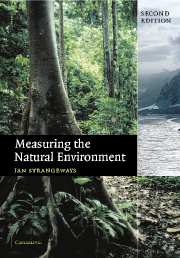Book contents
- Frontmatter
- Contents
- Acknowledgements
- 1 Basics
- 2 Radiation
- 3 Temperature
- 4 Humidity
- 5 Wind
- 6 Barometric pressure
- 7 Evaporation
- 8 Precipitation
- 9 Soil moisture and groundwater
- 10 Rivers and lakes
- 11 Data logging
- 12 Telemetry
- 13 Visibility
- 14 Clouds
- 15 Lightning
- 16 The upper atmosphere
- 17 The oceans
- 18 Cold regions
- 19 Remote sensing
- 20 Atmospheric composition
- 21 Forward look
- Appendix: abbreviations and acronyms
- Index
- References
13 - Visibility
Published online by Cambridge University Press: 05 July 2014
- Frontmatter
- Contents
- Acknowledgements
- 1 Basics
- 2 Radiation
- 3 Temperature
- 4 Humidity
- 5 Wind
- 6 Barometric pressure
- 7 Evaporation
- 8 Precipitation
- 9 Soil moisture and groundwater
- 10 Rivers and lakes
- 11 Data logging
- 12 Telemetry
- 13 Visibility
- 14 Clouds
- 15 Lightning
- 16 The upper atmosphere
- 17 The oceans
- 18 Cold regions
- 19 Remote sensing
- 20 Atmospheric composition
- 21 Forward look
- Appendix: abbreviations and acronyms
- Index
- References
Summary
When the sun rose there was a white fog, very warm and clammy, and more blinding than the night, it did not shift or drive; it was just there, standing all round you like something solid.
Joseph Conrad Heart of Darkness (from a boat far up the Congo river).Fog and mist figure deeply in the human psyche, casting an air of mystery and danger. Ships and boats still rely on reports of visibility, as now do aircraft, despite the arrival of radar; and lighthouses remain with us, albeit automated. But as a subject of scientific scrutiny, visibility is relatively new. It is surprisingly complex.
The variable and its history
Bouguer (1760), in his classic work on photometry, has a chapter on the transparency of the atmosphere. Thirty years later de Saussure (1789) (also inventor of the hair hygrometer) described a ‘diaphanometer’ for ‘measuring the clearness of air’, which although not very successful showed that he was aware of ‘air-light’ (below). Wild (1868) was the first to use photometric methods to measure the luminance of distant objects, but his theory was wrong, being based on the idea of absorption rather than scattering. Shortly after, however, the British mathematician Lord Rayleigh (1871a, 1871b, 1871c, 1899) wrote his classic papers on the scattering of light by air molecules and by small spherical particles, including the first correct explanation of why the sky is blue.
- Type
- Chapter
- Information
- Measuring the Natural Environment , pp. 320 - 342Publisher: Cambridge University PressPrint publication year: 2003



